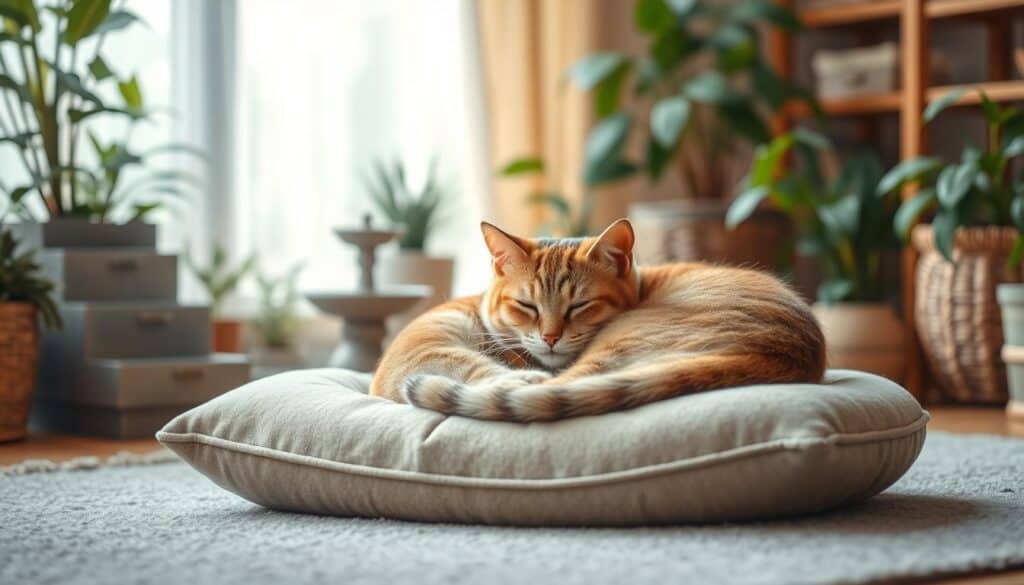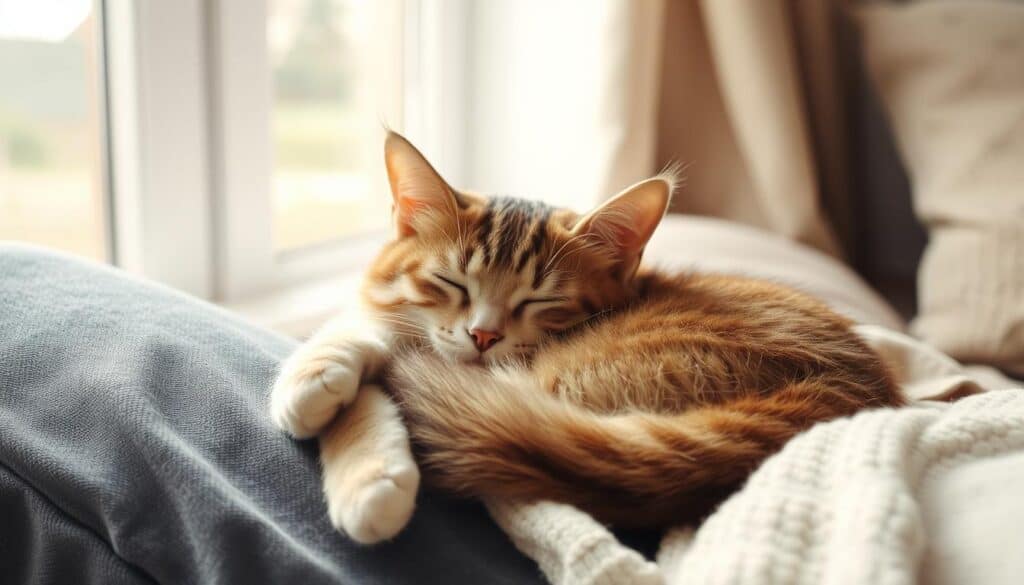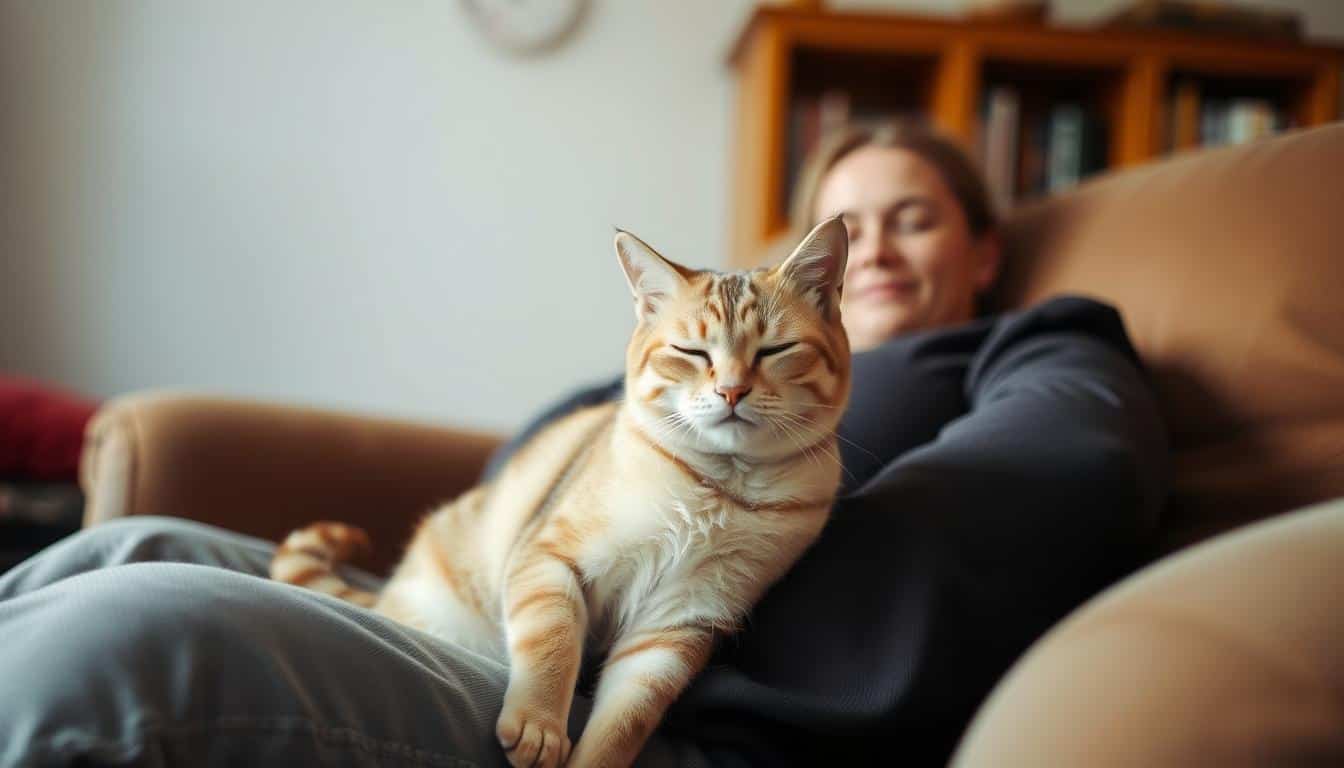Many cat owners find it funny yet confusing when cats sit on their laps. This behavior shows how much cats need warmth, comfort, and love from us. It’s a way for them to feel close to us.
By understanding this, we learn more about our cats. It helps us appreciate the special bond we share with them. This bond is built on trust and affection.
Key Takeaways
- Cats seek warmth and comfort when they sit on laps.
- This behavior is linked to their affectionate nature.
- Lap sitting fosters emotional bonds between cats and their owners.
- Understanding feline behavior helps improve cat-owner interactions.
- Some cats lap-sit due to instinctual needs for security.
The Comfort of Warmth
Cats love warmth, which is why they often sit on laps. The heat from humans makes them feel comfortable. Their bodies are a bit warmer than ours, so they seek out cozy spots.
How Body Heat Affects Cat Behavior
Human body heat changes how cats behave. They seek out heat because it makes them feel safe and relaxed. This is why they choose to sit on laps instead of finding a sunny spot.
When they get the chance, they snuggle up close. This lets them enjoy the warmth and comfort they find in human company.
Creating a Cozy Environment
To make a cozy spot for cats, owners can use soft blankets and heated mats. Plush cushions also help. These things make a space inviting for cats to snuggle up.
When the environment is cozy, cats feel more like staying. This leads to special moments and strengthens the bond between cat and owner. It turns simple times into memories they’ll always treasure.
Seeking Affection and Bonding
Cats have their own ways of showing love and seeking affection. Physical touch is key in bonding. When a cat sits on a person’s lap, it strengthens their emotional connection. This shows trust, as cats only feel safe with those they trust.
The Role of Physical Touch in Cat Affection
Physical touch is a main way cats communicate. Gentle strokes and cuddles make them happy and show they want to be with you. This touch releases oxytocin, the “bonding hormone,” making both feel warm and secure.
The lap becomes a special place for cats and owners to bond. It’s where they share moments of closeness and affection.
Building Trust with Your Feline Friend
Building trust with a cat is a journey. Regular touch is important to show safety and reassurance. When a cat sits on a lap often, it shows a strong bond and trust.
This interaction makes their relationship better. It creates a space where affection and communication grow.
Why do cats sit on your lap?
Cats show many behaviors that tell us about their needs and feelings. Knowing about cat behavior helps us understand why they like to be near us. Sitting on our laps is a key way they show their needs and bond with us.
Understanding Cat Behavior and Their Needs
When a cat sits on a lap, they look for warmth, safety, and comfort. Curling up on a human’s lap meets many of their needs at once. Cats are naturally social and seek closeness and security.
This instinct makes them want to bond with humans. It shows their need for companionship and reassurance.
The Importance of Human Interaction
Human interaction is key to a cat’s emotional health. Cats need attention and affection from their owners. By sitting on a lap, a cat shows they trust and bond with the human.
This interaction not only benefits the cat but also strengthens the bond between them and their owner. Learning why cats want to sit on our laps helps us understand their emotional needs. It makes their lives and ours richer.
Territorial Behavior
Cats have complex territorial instincts that shape their behavior. This understanding helps explain why cats sit on laps. For them, claiming space is more than comfort; it’s a deep instinct.
Claiming Their Space
When a cat sits on a person’s lap, they claim territory. This act shows their instinct to set boundaries and own their space. By sitting on their human, cats show that this space is theirs.
This act makes them feel secure and in control. It also brings them closer to their owner. The closeness strengthens their bond.
Marking You with Scent
Scent-marking is key in a cat’s territorial behavior. They have scent glands in their cheeks and paws. When they sit on laps, they rub against their owners, leaving their scent.
This act reinforces their claim and strengthens their bond. It shows their presence and connection. For owners, it reveals the deep instincts behind feline companionship.
Security and Protection
Cats have amazing behaviors that show their need for safety and protection. They often want to be close to their humans to feel safe. This is because they learned from their ancestors that being near their owners keeps them safe from danger.
When a cat sits on your lap, it’s clear they’re looking for security. This shows how important safety is to them.
Finding Safety in Proximity
Sitting on a lap is more than just being friendly. It’s a way for cats to find comfort and safety. Being near their owners makes them feel protected and at ease.
This closeness strengthens the bond between cats and their humans. The warmth of a lap makes it a cozy and safe spot for them.
Instinctual Behavior in Domestic Cats
Understanding why cats like to sit on laps involves knowing their instincts. In the wild, cats live in groups for safety. Today’s domestic cats have this instinct too, wanting to be close to their owners for the same reason.
This instinct is a big part of a cat’s nature. It drives them to seek safety and protection by being near their humans.
Reducing Stress and Anxiety

Sitting on a lap does more than just keep warm. It’s a key way for cats to reduce stress. This act brings comfort to both cats and their owners, creating a peaceful space. When a cat curls up on a lap, it looks for reassurance and feels secure with its owner nearby.
Lap Sitting as a Form of Comfort
Lap sitting shows a cat’s emotional connection. It’s more than just being close; it means they feel safe. The sound of a heartbeat can calm a cat, making both the cat and owner relax together.
How Cats Respond to Their Owner’s Emotions
Cats can sense when their owners are stressed or sad. They might sit on their lap to be close. This act helps the cat feel secure and attached to its owner’s emotional state. Knowing why cats sit on laps helps us understand their deep bond with us.
Why do cats want to sit on your lap during mealtime?
Cats often show interesting behavior at mealtime. They like to sit on our laps while we eat. This shows how much they value their bond with us.
Being on our lap makes them feel safe and loved. It’s a way for them to feel close to us during meals. This behavior is all about comfort and connection.
Cats and Their Unique Personalities
Exploring cat personalities can open a window into their world. Each cat has a special way of showing affection, which affects their lap-sitting habits. Some cats love to be close and cuddly, while others prefer to keep their distance. These differences tell us a lot about their comfort and emotional needs.
Individual Differences in Lap Sitting
Every cat is different when it comes to sitting on laps. Some cats can’t get enough of human attention and will snuggle up right away. Others might only sit on a lap sometimes, needing their own space. Things like how they were raised, past experiences, and instincts play a big role in this.
A social cat might want to be on its owner’s lap all the time. But a more reserved cat might prefer to sit next to its owner instead. This shows how important it is to understand each cat’s unique personality.
How Breed Influences Behavior
Cat breeds also play a big part in their lap-sitting habits. For example, Ragdolls and Maine Coons are very affectionate and love to be near their owners. On the other hand, Siamese cats are more vocal and interactive, but they might not always want to sit on a lap.
Knowing about these breed-specific traits helps us appreciate the special bond between humans and cats. It shows how different cats have their own ideas of what makes them comfortable.
Why do cats like to sit on your lap when you’re relaxing?

When you relax, cats often jump on your lap. This is because they have a strong instinct to be close to you. They sense your calmness and think it’s safe.
By sitting on your lap, cats show they trust and like you. They feel safe and warm, creating a peaceful bond. This is why they love to lounge near you, enjoying your heartbeat and the comfort of the moment.
Lap Sitting as a Social Behavior
Lap sitting shows a deeper side of cats’ social behavior. It shows they see humans as part of their group. They want to be close and feel safe.
Understanding Feline Social Structures
Cats live in different social groups, showing both cooperation and hierarchy. Lap sitting is a way for them to show they trust and want to be near. It’s about feeling safe and belonging.
Sitting on a human’s lap strengthens the bond between them. It makes the cat feel secure. Studying these behaviors helps us understand cats better, showing how important emotional connections are to them.
Why do cats sit on your lap on the toilet?
Cats sitting on their owner’s lap while they’re on the toilet is quite common. It shows how much cats love and trust their humans. They like to check out what their owners are doing, even in the bathroom.
These cats have a special need for social timing. They might think their human is doing something private and want to be there. It’s their way of saying they want to be close and feel safe.
When cats sit on the toilet, it means they really trust their owners. It’s a sign of a strong bond. They see even simple moments as chances to be together.
Why do cats sit on your lap and purr?
Cats sit on laps and purr to show they are happy and content. The sound of purring makes a calm atmosphere. It strengthens the bond between the cat and its owner.
This behavior shows their love and comfort. They pick the safest spot to relax and enjoy peace.
Purring is more than happiness; it’s a key part of the lap-sitting experience. As they settle, cats purr, showing mutual relaxation. It means they feel safe and can show their feelings freely.
Purring during lap time highlights the special bond between cats and humans. It shows their need for warmth and security. It also shows their deep connection with their owner.
This bond is key to their emotional well-being. It shows cats seek love and recognition. By understanding this, cat owners can see how their pets show affection and comfort.




